.
12.05.2015

ILS PROTON TO LAUNCH THE CENTENARIO SATELLITE
Payload:
Centenario Satellite
BSS-702HP GEM Platform
Separated spacecraft mass: 5325 kg
Launch Vehicle:
Proton M/Breeze M
705,000 kg (1,554,000 lb), including payload
58.2 m (191ft)
Launch Date:
May 16, 2015
Launch Time:
11:47 Baikonur
08:47 Moscow
00:47 Mexico
05:47 GMT
01:47 EDT
Launch Site:
Baikonur Cosmodrome, Kazakhstan
Launch Pad 39
Launch Customer:
The Secretaria de Comunicaciones y Transportes (SCT), Mexico
Satellite Manufacturer:
Boeing Satellite Systems International, California, USA
Launch Vehicle Manufacturer:
Khrunichev State Research and Production Space Center,
Moscow, Russia
Launch Services
Provider:
International Launch Services, Virginia, USA
Satellite Use:
Weighing over 5.3 metric tons at lift-off, the Centenario satellite is a fourth generation Boeing
satellite to serve Mexico and the first 702HP GEM for Mexico. Centenario will provide mobile
satellite services to support national security, civil and humanitarian efforts and will provide
disaster relief, emergency services, telemedicine, rural education, and government agency
operations The satellite carries a 22 meter L-band reflector that enables connectivity to
handheld terminals, complemented by a 2-meter Ku-band antenna. The Centenario satellite is
part of an end-to-end satellite communications system that provides 3G+ communications
services for voice, data, video and internet access to terminals on multiple
platforms. This next-generation satellite system for Mexico consists of three satellites, two
ground sitesand associated network operations. It is Mexico’s next-generation satellite
communications system.
Satellite Statistics:
_L-band multi-spot beam flexible payload for Mobile Satellite Services (MSS)
_Planned orbital location: 113.1 degrees West longitude
_Anticipated service life: 15 years
Mission Profile:
The Proton M launch vehicle, utilizing a 5-burn Breeze M mission design, will lift off from Pad 39 at 13:07 local time (2:07 am Mexico time, 7:07 am GMT) from the Baikonur Cosmodrome in Kazakhstan, with the Centenario satellite on board. The first three stages of the Proton utilize a standard ascent profile to place the orbital unit (Breeze M upper stage and the Centenario satellite) into a sub-orbital trajectory. From this point in the mission, the Breeze M will perform planned mission maneuvers to advance the orbital unit first to a circular parking orbit, then to an intermediate orbit, followed by a transfer orbit, and finally to a geosynchronous transfer orbit. Separation of the Centenario satellite will occur approximately 9 hours, 13 minutes after liftoff.
Target Orbit at Separation:
_Perigee: 4163
_Apogee: 35736 km
_Inclination: 23.0 degrees
Spacecraft Separation:
Approximately 9 hours and 13 minutes after lift-off
ILS Mission Statistics:
_2nd ILS Proton Launch in 2015
_89th ILS Proton Launch Overall
_1st SCT satellite launched on ILS Proton
_18th Boeing Satellite Launched on Proton
Live Broadcast:
LAUNCH – 16 May, 2015
Baikonur to Washington Eutelsat 10A will begin at 0100 Eastern/0500 GMT
Live test for Mexico will begin at 0100 Eastern/0500 GMT
Live Broadcast starting at 0130 Eastern/0530 GMT
Launch is scheduled for 01:47:39 Eastern/05:47:39 GMT
Launch Broadcast concludes at 0215 Eastern/00615 GMT
BAIKONUR TO WASHINGTON KHRUNICHEV U/L (SD)
EBU REF 15/034178/01
EUTELSAT 10A 10 deg East TXP B3 CHANNEL 6MHZ SLOT 3D6
UPLINK FREQ.: 14360 MHZ POL Y
DOWNLINK FR.: 11060 MHZ POL X
SD 625 16:9 50Hz DVB-S2 8PSK 4.9373 Ms/s FEC 3/4,
Pilot:on Roll-off 0.20 (MPEG2 4:2:2 10.7514 Mbps)
AUDIO:1 SOUND MONO
AUDIO:2 SOUND MONO
AUDIO:3 N/A
AUDIO:4 N/A
In Mexico, THE LAUNCH BROADCAST WILL BE SEEN ON THE FOLLOWING (HD)
Eutelsat 113WA / C101(F) (Formerly SatMex 6)
U/L; 5949.5, D/L 3724.5
Beam; C1
Pol; H uplink/V downlink
9 MHz
DVB-S2 8PSK, MPEG 4 (H.264):
FEC: 3/4
Sym Rate: 7.5
Info Rate: 16.331
Pilot On
H.264 (MPEG 4)
Roll-Off 20%
Quelle: ILS
.
Update: 15.05.2015
.
Russia Proton-M Carrier Rocket to Deliver Mexican Satellite to Orbit
According to Russian Space Agency, launch of Mexico’s MexSat-1 communications satellite on a Russian Proton-M carrier rocket from the Baikonur Space Center in Kazakhstan is scheduled for May 16.
The launch of Mexico’s MexSat-1 communications satellite on a Russian Proton-M carrier rocket from the Baikonur Space Center in Kazakhstan is scheduled for May 16, a Russian Space Agency source told RIA Novosti on Friday.
“The launch of the Proton-M is scheduled for May 16 at 8:48 a.m. Moscow time [05:48 GMT],” the Roscosmos source said.
The 5.4-ton MexSat-1 satellite provides communication services for Mexico and parts of South America.
Quelle: Sputnik
-
Update: 16.05.2015
.
Russian Rocket Carrying Mexican Satellite Crashes in Siberia
A Russian rocket carrying a Mexican satellite malfunctioned and crashed Saturday in Siberia shortly after its launch — the latest mishap to hit Russia's troubled space industry, whose Soviet-era glory has been marred by a series of launch failures.
The rocket, a Proton-M, was launched from the Russia-leased Baikonur launch pad in Kazakhstan on Saturday morning.
Roscosmos, the Russian Federal Space Agency, in a statement described the accident as a malfunction and said it was looking into what had happened. Russian news agencies quoted authorities in eastern Siberia as saying they are searching for the third stage of the rocket, which is believed to have crashed in the Zabaikalsky region that borders Mongolia and China.
There were also concerns about the tons of toxic fuel the rocket was carrying, which could have exploded at the crash site. Roscosmos would not provide any further details about the accident, including the exact site of the crash.
The Proton-M rocket has a history of mishaps, leading to the loss of three navigation satellites last year.
The Interfax news agency quoted industry sources saying the crash could result in the suspension of all upcoming Proton-M launches, including the next one in June for a British satellite.
In a separate space failure Saturday, Roscosmos also reported that the Progress spaceship failed to ignite its engine and failed to adjust the orbit of the International Space Station. The agency said it was looking into why that happened and said the space station's crew was not in any danger from the incident.
Observers say post-Soviet Russia's space program has been hampered by a brain drain and a steady erosion of engineering and quality standards.
In April, an unmanned Russian space supply ship carrying 3 tons of goods failed to dock with the International Space Station after it went into an uncontrollable spin after the launch.
That failure prompted Roscosmos to delay both the landing of some of the space station's crew and the launch of their successors. Roscosmos space agency chief Igor Komarov said the April 28 launch failure was caused by a leak of fuel tanks in the Soyuz rocket's third stage. Left in low orbit, the Progress cargo spaceship fell to Earth over the Pacific on May 8.
A Russian official said three of the orbiting space station's six-person crew, who had been scheduled to return to Earth in early May, were asked to stay in orbit until early June and the launch of their replacement crew was pushed back from late May to late July.
Quelle: abc-news
-
Helicopter of Emergencies Ministry to check area where Proton’s debris may fall
An emergency situation happened during the flight of Proton-M carrier, which was launched on Saturday from the Baikonur cosmodrome at 08:47 Moscow time
MOSCOW, May 16. /TASS/. A Mi8 helicopter of Russia’s Emergencies Ministry has left for an area, to where debris of Proton-M carrier may fall, a source at the space sector told TASS on Saturday.
"From the Khilok settlement in the Chita region, the helicopter went to the proposed area, which is about 130 kilometres from the settlement," the source said.
Local residents have not reported or claimed anything regarding possible debris.
An emergency situation happened during the flight of Proton-M carrier, which was launched on Saturday from the Baikonur cosmodrome at 08:47 Moscow time, at 08:56 Moscow time, one minute to the scheduled separation of the Briz-M booster and the Mexican MexSat-1 space apparatus, which was to be taken to the orbit.
Quelle: TASS
-
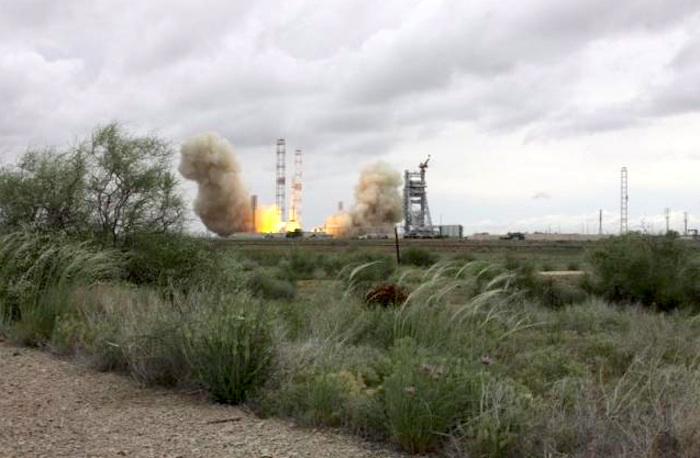
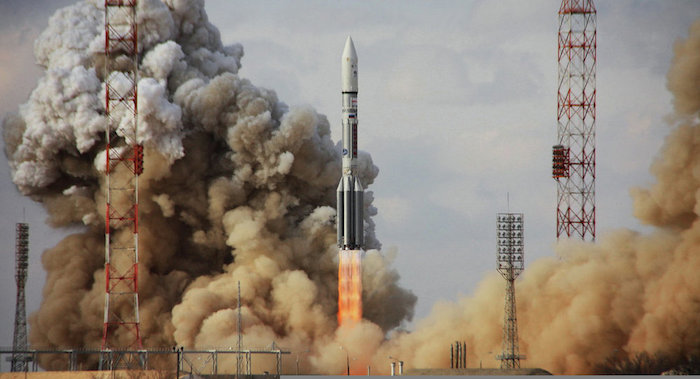
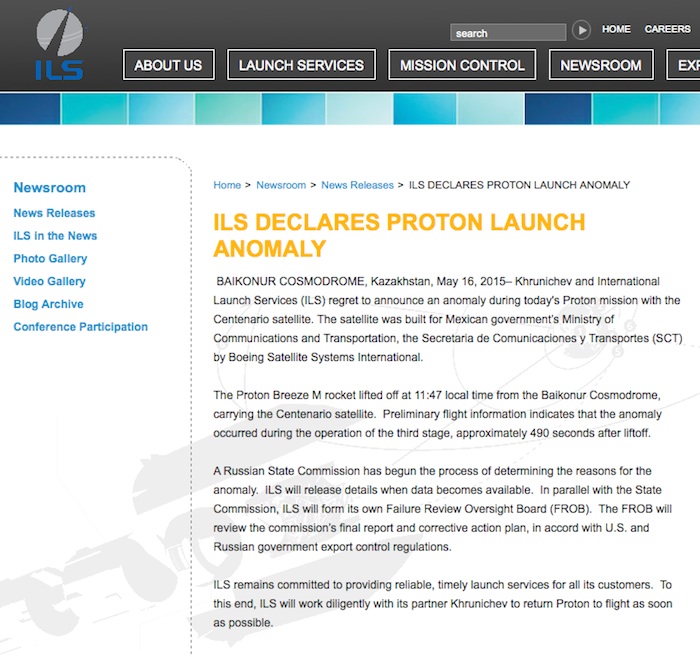
Quelle: ILS
-
Russian Proton rocket fails on satellite mission
Anatoly Zak, Russian Space Correspondent
Sen—The Russian space program has suffered another launch failure, crippling its commercial operations, just weeks after a major accident grounded the main carrier of its human missions.
The Proton rocket lifted off from Baikonur Cosmodrome in Kazakhstan on Saturday, May 16, carrying the MexSat-1 communications satellite for the Mexican government. The initial phase of the flight seemed to go smoothly until an official commentator suddenly declared a "non-nominal situation" and interrupted the live broadcast of the launch slightly more than eight minutes into the flight, during the operation of Proton's third stage.
The International Launch Services (ILS), which markets Proton missions to commercial customers around the world, also covered the initial phase of the mission live, however could not confirm the status of the rocket or the satellite by the end of its broadcast. The company's representative admitted some loss of telemetry from the mission, however reported that other available information, including data from NORAD radar had indicated a normal flight.
After several minutes of confusion, the official Russian media reported that the launch had failed during the operation of the rocket's third stage. According to the Interfax news agency quoting unnamed sources, the remnants of the vehicle had been expected to crash in the Chita Region in Eastern Russia.
According to preliminary analysis of available telemetry, a failure of steering engines on the third stage could have caused the accident, the agency reported.
In the meantime, an online broadcast of key mission milestones based on the live telemetry from the launch came with a considerable delay and stopped before the planned engine cutoff on the third stage of the Proton rocket.
Around half an hour after the accident, the Russian space agency (Roscosmos) announced that a "non-nominal situation" had taken place during the Proton launch and its cause had to be investigated. The same press-release also said that a planned orbit correction of the International Space Station (ISS) with the engines of the Russian Progress cargo ship had not taken place either.
A similar Progress ship was lost moments after its separation from the third stage of the launch vehicle on April 28. Although the root cause of the accident still remains unknown, the Soyuz-2-1a rocket was blamed, leading to a domino effect of delays in the operation of the ISS.
After the latest accident with the Proton, the two main rocket families in the Russian rocket fleet are out of commission.
-
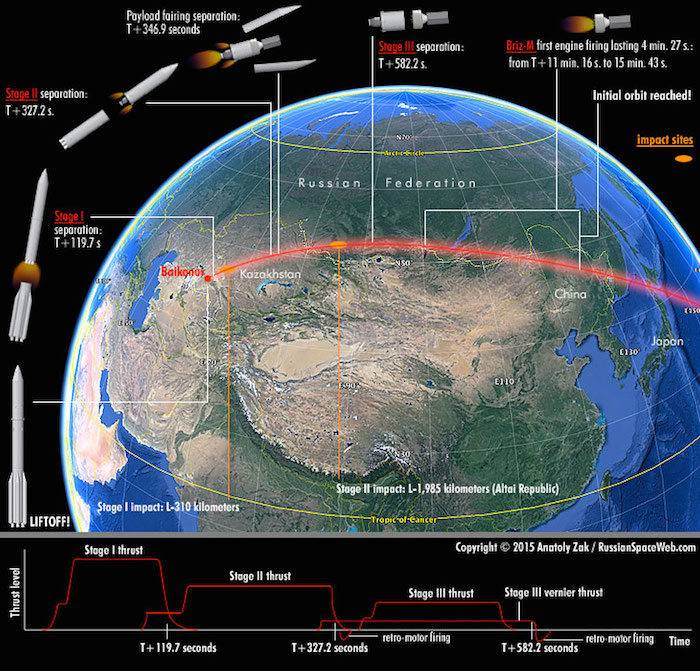
A nominal flight profile of the Proton rocket with the MexSat-1 communications satellite.
Quelle: SEN
-
Update: 22.00 MESZ
.
No threat to environment after Proton rocket accident - Russia’s met office
MOSCOW, May 16. /TASS/. An accident with the Proton-M rocket carrier poses no threat to environment, Russia’s Roshydrometcentr meteorological office said on Saturday.
"According to data available by the Roshydrometcentr Situational Centre, assessments of possible aftermaths carried out by specialists of the Roshydromet Typhoon research centre testify that there is no threat of environmental pollution for Russia and bordering states resulting from the accident," the press service said.
An emergency situation happened during the flight of Proton-M carrier, which was launched on Saturday from the Baikonur cosmodrome at 08:47 Moscow time. At the 497th second, one minute to the scheduled separation of the Briz-M booster and the Mexican MexSat-1 space apparatus, which was to be taken to the orbit, an emergency situation was fixed in the rocket-carrier’s third stage. The third stage and the satellite were falling from the height of 161 kilometres, which is sufficient to have all the debris burn up in the atmosphere. The area where they may fall is south-west of the Siberian Baikal region. A preliminary reason of the accident with Proton is a failure of the steering engines of the third stage.
Initially, the launch had been planned for April 29, but was postponed at the client’s request. Boeing, which made the apparatus, needed more time to check the equipment on board.
An interdepartmental commission will look into circumstances of the emergency and make appropriate decisions.
---
Proton fragments not found in Russia’s Baikal area - Emergencies Ministry
MOSCOW, May 16. /TASS/. Fragments of the Proton-M rocket have not been recovered in the area near to Lake Baikal but the search operation is underway, the Russian Emergencies Ministry’s press service told TASS on Saturday.
"According to local authorities’ reports, rocket fragments have not been detected, there is neither destruction nor fumigation," the spokesperson said. "The population and economic facilities are not facing any danger."
Operative crews and the ministry’s aircraft are scouring the area, the press service said.
"Residents in the area near Lake Baikal have been informed immediately amid the abnormal situation following the Proton-M rocker carrier launch," he said. "The local emergences subsystem has been engaged in the search operation in the region. Russia’s Emergencies Ministry’s operative crews alongside local authorities have inspected economic and housing facilities".
---
Roskosmos requests weather data in area of Proton's possible falling
A source at local law enforcement authorities added "there are unconfirmed reports about fallen debris in Krasnochikoy district
.
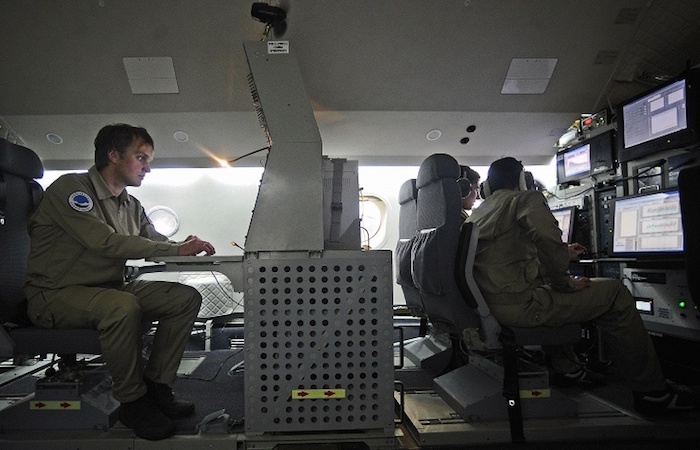
Russia's space authority, Roskosmos, has requested from weather forecaster Roshydromet information about weather conditions in the area of Proton's possible falling in Baikal region, a source in the space sector told TASS on Saturday.
"As the poisonous fuel remained in the rocket's tanks, during the falling it could spread in the atmosphere," the source said. "Thus, Roskosmos was asking about wind directions and possible precipitation."
A source told TASS earlier on Saturday, a Mi8 helicopter of Russia’s Emergencies Ministry has left for an area, to where debris of Proton-M carrier may fall.
"From the Khilok settlement in the Chita region, the helicopter went to the proposed area, which is about 130 kilometres from the settlement," the source said.
Local residents have not reported or claimed anything regarding possible debris.
A source at local law enforcement authorities added "there are unconfirmed reports about fallen debris in Krasnochikoy district." "It is a distanced territory, and specialists are to verify the information."
There is no information about casualties or destruction.
An emergency situation happened during the flight of Proton-M carrier, which was launched on Saturday from the Baikonur cosmodrome at 08:47 Moscow time, at 08:56 Moscow time, one minute to the scheduled separation of the Briz-M booster and the Mexican MexSat-1 space apparatus, which was to be taken to the orbit. The third stage and the satellite were falling from the height of 160 kilometres, which should be sufficient to have all the debris burn up in the atmosphere. The area where they may fall is south-west of the Siberian Baikal region. A preliminary reason of the accident with Proton is a failure of the steering engines of the third stage.
Initially, the launch had been planned for April 29, but was postponed at the client’s request. Boeing, which made the apparatus, needed more time to check the equipment on board.
Proton’s previous launch was on March 19, where it took to the orbit Russia’s Express-AM7 communications satellite.
Precisely a year ago, the carrier rocket Proton-M, which was launched from Baikonur together with the communications satellite Express-AM4R, has burnt up in the dense layers of the atmosphere. The non-deployment of the communications satellite Express-AM4R into orbit was caused by an abnormal situation, Irina Zubareva, press secretary of the Roskosmos director, told TASS then.
Quelle: TASS
.
Update: 17.05.2015
.
Mexico not to suffer financially due to loss of satellite after Proton accident — Minister
According to Esparza, the satellite was insured for its full value and "this sum will be fully refunded"
MEXICO CITY, May 17. Mexico will not sustain economic losses due the loss of its MexSat-1 communications satellite following the crash of the Proton-M carrier, Mexico’s Minister of Communications and Transportation Gerardo Ruiz Esparza told a news conference in the city of Hermosillo on Saturday.
© Roskosmos
Medvedev orders to set up commission for identifying responsible for Proton failure
According to Esparza, the satellite was insured for its full value and "this sum will be fully refunded." He added that the Mexican authorities had invested $300 million in the creation of the satellite and another $90 million - in its blast off from the Baikonur space port."
Commenting on the Proton crash, the minister noted that "it was quite clear that such risks did exist" during the launch of a space vehicle.
Quelle: TASS
5389 Views
